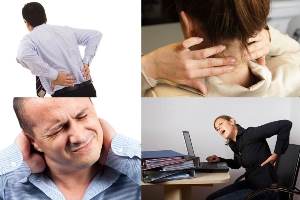Can Poor Posture Really Cause Back and Neck Pain?
Unless your back or neck pain has been caused by some type of over-exertion or acute trauma, it’s actually very likely that poor posture is at least a contributing factor. The alignment of the spine—from the neck through the lower back and hips—is critical to the body’s ability to support its own weight and move efficiently, so posture problems (which are often chronic) can gradually lead to pain and reduced mobility.
When it comes to pain in your back or neck, the relationship between poor posture and injury can also be a complicated one. On the one hand, having poor posture makes it more likely that you will suffer an injury. On the other hand, suffering an injury can also affect your posture. Mary Ann Wilmarth, DPT, spokeswoman for the American Physical Therapy Association explains, “Little things add up. You can increase the pressure on your back by 50% simply by leaning over the sink incorrectly to brush your teeth. Keeping the right amount of curvature in the back takes pressure off the nerves and will reduce back pain.”
How posture problems contribute to neck pain
One of the most common posture problems is a “forward head and shoulder posture”. This occurs when someone “hunches over” and places their head in front of their neck. The weight of the head towards the front stresses the lower neck vertebrae, and leads to overworking of the upper back muscles to compensate for the pull of gravity on the head. Many people with this posture problem also have a rounded upper back and rounded shoulders, which can lead to further stress and shoulder pain. Often, poor desk and chair ergonomics contribute to these problems, but even slouching on the couch or at a table with your mobile phone can lead to hunching over.
How posture problems contribute to back pain
The “forward head” posture described above causes stress on the lower cervical vertebrae, which may end up sliding forward relative to each other as a result of gravity. This is a particular problem for people who have jobs requiring them to look forward or downwards all day. Eventually, the prolonged pressure on the cervical vertebrae will irritate the ligaments and soft tissues, radiating downwards to the upper back. This process can lead to disc degeneration, cervical osteoarthritis and herniated discs.
Tips for improving poor posture and relieving back and neck pain
Poor posture is typically the result of habits that have been developed over long periods of time performing the same activities over and over again. Here are just a few of the most common culprits:
- Staring at computer monitors or mobile devices that are badly positioned.
- Sitting in poorly designed office chairs.
- Sleeping on mattresses that don’t provide the necessary support.
- Carrying heavy backpacks or purses.
But how do you know which activities are contributing to your poor posture and causing you pain? The clues are usually fairly easy to spot once you know what you’re looking for. For instance, the pain in your neck or back may be worse at some times during the day than at others, or it may come and go with changes in your body position. If you experience fatigue or pain when you first wake up in the morning or after you’ve been sitting at your desk for a couple of hours, it might be time for a new mattress or new office furniture.
The good news is that once you become aware of the activities that are contributing to your posture problems and pain, most can be fixed relatively easily, with no need for either medication or surgery. Learn to recognize when you’re hunching over your computer, slouching in your chair or craning your neck to look at your mobile phone. Then sit up straight, aligning your hips, shoulders and ears in one vertical line.
Sometimes, however, the solution is not so simple—especially when poor posture has caused structural changes in the spine and neck. In these cases, a chiropractor can help by designing posture correction and spinal rehabilitation programs to restore the spine’s normal curvature. These programs will usually involve a combination of mechanical techniques that actively remodel the spine (including the use of braces and molding blocks), exercises and stretches that strengthen postural muscles and restore range of motion, and lifestyle changes to address the root causes.
As experts in diagnosing and treating musculoskeletal conditions, chiropractic physicians are specially trained to recognize and correct postural problems. If you’re suffering from neck or back pain and suspect that your posture may be at least partially to blame, call or visit our office today. We can help!









